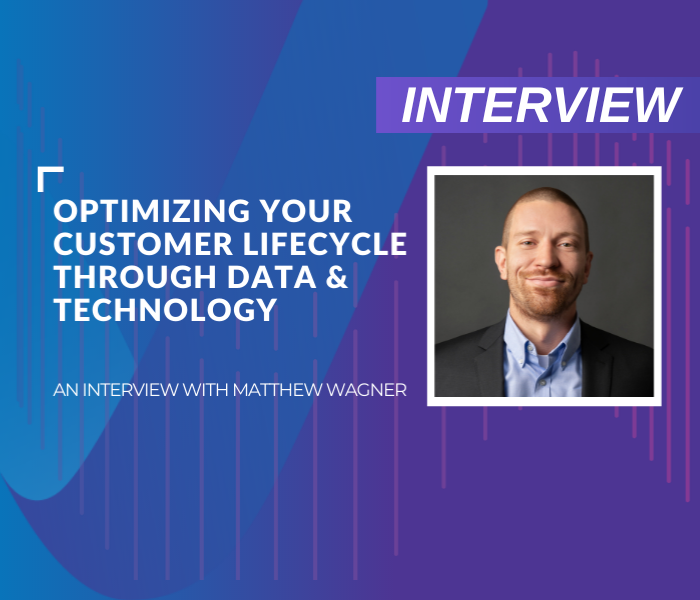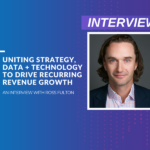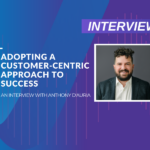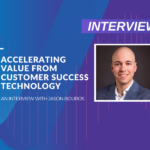Suffering From Siloed Customer Data?
80% of leading businesses believe a single source of customer data would create significant and indispensable value for their company and their customers (Salesforce, 2019). Data-driven organizations are better equipped to anticipate their customers’ needs, incorporate value into every customer engagement, and build Agility into their processes and systems. Without customer data integration, robust insights and a powerful platform to operationalize your various customer lifecycle activities, you’re limiting your organization’s ability to deliver exceptional customer value across the customer journey and achieve best-in-class revenue retention and expansion.
To find out how you can enable your high-performing teams to make data-driven decisions using a thorough data and technology toolkit, I spoke with Matthew Wagner, Principal Software Developer at Valuize. Matthew has over a decade of experience as a developer with an extensive background in Support, Integration, and Product development. In this interview, Matthew shares his insights on the biggest challenges enterprise organizations face in their quest to unite their customer lifecycle data and reveals how organizations can leverage technology to streamline customer value delivery and realization.
Q: What was your first job? How did you get started with helping companies leverage technology and data to optimize their customer lifecycles?
A: “My first job ever was as a bag boy at IGA, a grocery store chain in Western Canada. For the last 10 years, I’ve been working as a Software Developer. During that time, I took on a role that was heavily focused on streamlining internal processes, serving other business units within the organization, and development within Salesforce and Gainsight instances. That’s where my journey into customer lifecycle optimization truly began.”
Q: What excites you about working in the customer lifecycle domain with a specific focus on data and technology? How do you think the domain will continue to evolve from here?
A: “Overall, it’s an exciting time to be in the customer lifecycle space. As it’s a relatively new domain, things are constantly changing – new technologies and innovations are introduced all the time. That’s what I live for as a developer – an Agile and evolving environment where I have the freedom and opportunity to learn and express myself.
Over the next 5 years, I think we’re going to see a solidification of methodologies and best practices, as well as concrete software being built and applied to customer lifecycle optimization. Crucially, we’re going to see which technologies are pulling ahead and cementing their status as the go-to tech solution in the industry.”
Q: Why do you think customer data integration is an important investment for organizations?
A: “Data drives business – this has always been true. As it pertains to Customer Success specifically, defining your master customer data and ensuring its consistency allows for that data to flow through not only your Success applications, but your entire customer-centric ecosystem, including Sales, Marketing, Analytics and Product. Crucially, it also enables your organization to take both qualitative and quantitative action from the data, ensuring that your processes and customer engagements are built on concrete, data-driven insights.”
Q: What are some of the common challenges that enterprise organizations face when working with customer data?
A: “When it comes to data, the biggest challenge that I see organizations facing is customer data integration. There are many complications associated with integrating data, transforming it or organizing it in systems. If we look at the entire ecosystem of applications within an organization, a lot of these pre-built software solutions allow for connections to be made directly with other pieces of software in your organization, which creates a spider web of integration. This results in a very convoluted definition for your single source of truth and prevents your teams from accessing a holistic and real-time view of customer data.
Another issue that is prevalent among B2B tech organizations is using the wrong software to act as the source of truth for customer data. Many applications lack in functionality and ability to act as a Source of Truth (SOT), negatively impacting how data can be utilized elsewhere within your organization. This is why it’s critical to conduct a thorough pre-purchase analysis of the various software options with precise evaluation criteria.”
Q: As companies look to better manage the customer lifecycle, there is some debate over build versus buy. In your experience, what are the benefits of buy versus build and what should companies consider when making this important decision?
A: “If you can, buy! Building is a huge investment, and not just from a monetary perspective. If you build, you’re facing substantial infrastructure costs, considerable resource allocation, and, most importantly, a massive time investment. It takes a lot of time to build something from scratch, and even more time to do it right. When you buy, you can immediately pick up a product and, while it may not be tailor-made to your exact use case, you can typically get 95% of the way there in 1/100th of the time, energy and cost of building something yourself.”
Q: What are the key factors that B2B technology organizations should consider when selecting and operationalizing the right technology for their customer lifecycle strategy?
A: “First and foremost, define your objectives and processes. Once you have those clearly outlined, you can then evaluate your functional and usability requirements based on your customer engagement model and organizational structure. Lastly, ensure that whichever software you’re considering can grow with your business as you scale. You don’t want to be pigeonholed into using your technology platform in the exact same way that you were using it on day one when you had a company of X number of people and only 20 processes. This will limit your ability to scale successfully and potentially lead to lost retention and expansion revenue.”
Q: In your experience, what are some key challenges that software organizations are facing when it comes to the operationalization of processes in CS technology like Gainsight? How do you recommend that leaders navigate these challenges for a successful implementation?
A: “The top two challenges that I see many organizations facing are defining master customer data and overcoming cross-departmental blockades. Successful implementation and operationalization of any technology requires cross-organizational buy-in. Champions need to be clearly identified within your organization to enable these crossover objectives to be driven to completion and they should have complete ownership associated with that goal.
Cross-organizational blockades are usually, but not always, the cause of issues with the definition of master customer data and how cross-functional teams utilize it. Your master customer data needs to be defined early, it needs to be defined accurately, and you need to ensure that your champions drive this data across the organization.”
Q: How do you recommend that software leaders make the most of their customer data and lay the groundwork to successfully leverage innovations in Customer Intelligence?
A: “Software leaders need to focus on obtaining buy-in and establishing master customer data. Regardless of the department you’re heading, you need to gather all of this valuable information into a data warehouse and leverage these insights as a single source of truth. This will also help you define thoughtful processes and functions across your organization.”
Bonus Q: What’s your favorite way to spend a Sunday?
A: “I have a laundry list of home renovation projects that need to get done, so that’s a non-negotiable part of my weekend for the foreseeable future. I spend half my time working through my home renovations list and the other half trying to keep my three little girls entertained!”
Accelerate Your Data-Driven Capabilities
Optimize your customer lifecycle with data-driven insights with Matthew’s top 3 recommendations:
- To capitalize on all your valuable and varied customer data, you need a system that acts as your single source of truth that is easily accessible and available to each customer-facing team. This single source of truth will empower your organization to derive data-driven actions that optimize the various processes, touchpoints and engagement in your customer lifecycle.
- In order to build your customer lifecycle initiatives for the long-term, you need to select a technology that can evolve with your organization as you scale. The exponential organizational, customer and data demands of an enterprise organization are vast and complex and require a technology solution that is able to keep pace effectively and efficiently.
- To ensure the ongoing success of your technology investment, appoint a champion that is well-equipped to partner with your cross-functional teams. With a champion at the helm of your customer lifecycle optimization, you will significantly expand your chances of increasing your organization’s adoption and deployment of your selected software.
A successful implementation and adoption of any change, especially a customer lifecycle transformation, requires providing your teams with ample support and enablement. Follow these 5 steps to master organizational change management and guarantee the success of your technology investment and customer data integration.





